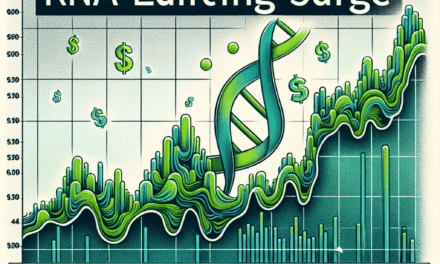“S&P 500 Soars: Wall Street’s Winning Streak Nears Historic Heights!”
Introduction
The S&P 500 is approaching a significant milestone, nearing the 6,000 mark, as Wall Street anticipates what could be the best week of the year for the stock market. This surge reflects growing investor optimism driven by a combination of robust corporate earnings, favorable economic data, and easing concerns over inflationary pressures. The rally underscores the resilience of the U.S. equity market amid global uncertainties, with major sectors contributing to the upward momentum. As traders and analysts closely monitor these developments, the S&P 500’s performance is seen as a barometer of broader economic confidence and market sentiment.
Market Trends: S&P 500 Approaches 6,000 Milestone
As the S&P 500 approaches the significant milestone of 6,000 points, investors and analysts alike are closely monitoring the market’s performance, which is on track to deliver its best week of the year. This remarkable ascent underscores the resilience and optimism that have characterized Wall Street’s recent trajectory, despite a backdrop of economic uncertainties and global challenges. The index’s upward momentum can be attributed to a confluence of factors, including robust corporate earnings, accommodative monetary policies, and a renewed sense of investor confidence.
Corporate earnings have played a pivotal role in propelling the S&P 500 towards this milestone. Many companies have reported stronger-than-expected quarterly results, driven by increased consumer spending and operational efficiencies. This positive earnings season has not only bolstered individual stock performances but has also contributed to a broader sense of market stability. Furthermore, sectors such as technology, healthcare, and consumer discretionary have been standout performers, reflecting their adaptability and growth potential in a rapidly changing economic landscape.
In addition to strong corporate earnings, the Federal Reserve’s monetary policy has been a crucial factor in supporting the market’s upward trajectory. The central bank’s commitment to maintaining low interest rates has provided a favorable environment for both businesses and consumers. This accommodative stance has encouraged borrowing and investment, fueling economic activity and, by extension, stock market gains. Moreover, the Fed’s cautious approach to tapering its asset purchase program has reassured investors that any policy adjustments will be gradual and measured, thereby minimizing potential market disruptions.
Investor confidence has also been buoyed by signs of economic recovery, particularly in the wake of the COVID-19 pandemic. As vaccination rates have increased and restrictions have eased, economic activity has picked up, leading to improved labor market conditions and consumer sentiment. This renewed optimism has translated into increased market participation, with both institutional and retail investors seeking opportunities to capitalize on the recovery. The influx of capital into the market has further propelled the S&P 500 towards its 6,000-point target.
However, it is important to acknowledge the potential risks and challenges that could impact the market’s trajectory. Inflationary pressures remain a concern, as rising prices could erode purchasing power and prompt the Federal Reserve to adjust its monetary policy more aggressively than anticipated. Additionally, geopolitical tensions and supply chain disruptions continue to pose threats to global economic stability. Investors must remain vigilant and adaptable, as these factors could introduce volatility and uncertainty into the market.
Despite these challenges, the S&P 500’s approach to the 6,000-point milestone is a testament to the resilience and adaptability of the financial markets. As Wall Street eyes its best week of the year, the focus remains on sustaining this momentum while navigating the complexities of the current economic environment. The interplay of corporate performance, monetary policy, and investor sentiment will continue to shape the market’s path forward. As such, stakeholders must remain informed and proactive, leveraging insights and strategies to optimize their positions in this dynamic landscape. In conclusion, while the journey to 6,000 points is not without its hurdles, the S&P 500’s progress reflects a broader narrative of recovery and growth, offering a glimpse of optimism for the future.
Investor Sentiment: Wall Street’s Optimism Amid S&P 500 Surge
Investor sentiment on Wall Street has reached a crescendo as the S&P 500 approaches the 6,000 mark, a milestone that signifies not only a robust recovery but also a potential record-setting week for the index. This surge is emblematic of the broader optimism that has permeated financial markets, driven by a confluence of factors that have bolstered investor confidence. As the S&P 500 edges closer to this significant threshold, market participants are keenly observing the dynamics that have contributed to this upward trajectory.
One of the primary drivers of this optimism is the recent string of positive economic data, which has painted a picture of resilience and growth in the U.S. economy. Key indicators such as employment figures, consumer spending, and manufacturing output have all shown signs of strength, suggesting that the economic recovery is gaining momentum. This has alleviated some of the concerns that had previously weighed on investor sentiment, particularly those related to inflationary pressures and potential interest rate hikes by the Federal Reserve.
Moreover, corporate earnings have played a pivotal role in fueling the rally. Many companies have reported better-than-expected earnings, underscoring their ability to navigate the challenges posed by supply chain disruptions and rising input costs. This has not only reassured investors about the health of corporate America but has also led to upward revisions in earnings forecasts, further supporting the bullish sentiment.
In addition to these fundamental factors, the market has also been buoyed by a favorable policy environment. The Federal Reserve’s commitment to maintaining accommodative monetary policy, at least in the near term, has provided a supportive backdrop for equities. This dovish stance has helped to keep borrowing costs low, encouraging investment and spending, which in turn has contributed to the positive market sentiment.
Furthermore, geopolitical developments have also played a role in shaping investor sentiment. Recent diplomatic efforts to de-escalate tensions in various global hotspots have reduced some of the geopolitical risks that had previously cast a shadow over the markets. This has allowed investors to focus more on the underlying economic fundamentals rather than external uncertainties.
As the S&P 500 approaches the 6,000 mark, it is important to consider the potential implications of this milestone. While it is a testament to the resilience and adaptability of the market, it also raises questions about sustainability and valuation. Some analysts caution that the rapid ascent of the index may lead to overvaluation concerns, prompting a more cautious approach among some investors. However, others argue that the current environment, characterized by strong economic growth and supportive monetary policy, justifies the elevated valuations.
In conclusion, the S&P 500’s approach to the 6,000 mark is a reflection of the prevailing optimism on Wall Street, driven by a combination of strong economic data, robust corporate earnings, and a supportive policy environment. While there are valid concerns about sustainability and valuation, the current sentiment suggests that investors remain confident in the market’s ability to continue its upward trajectory. As Wall Street eyes what could be the best week of the year for the S&P 500, the focus will likely remain on the interplay between economic fundamentals and market dynamics, as investors navigate the path forward.
Economic Indicators: Factors Driving the S&P 500’s Rise
The S&P 500’s approach towards the 6,000 mark has captured the attention of investors and analysts alike, as Wall Street anticipates what could be the best week of the year for the index. This remarkable ascent is underpinned by a confluence of economic indicators and market dynamics that have collectively fostered a favorable environment for equities. Understanding these factors provides insight into the current market sentiment and the potential trajectory of the S&P 500.
To begin with, robust corporate earnings have played a pivotal role in propelling the S&P 500 towards this milestone. Many companies have reported earnings that exceeded analysts’ expectations, driven by strong consumer demand and operational efficiencies. This earnings momentum has instilled confidence among investors, who view these results as a testament to the resilience and adaptability of businesses in navigating post-pandemic challenges. Furthermore, sectors such as technology and healthcare have been standout performers, contributing significantly to the index’s upward trajectory.
In addition to corporate earnings, macroeconomic indicators have also been favorable. The labor market has shown signs of strength, with unemployment rates declining and job creation numbers surpassing forecasts. This improvement in employment conditions has bolstered consumer confidence, leading to increased spending and investment. Moreover, inflation, while still a concern, has shown signs of stabilizing, alleviating fears of runaway price increases that could erode purchasing power and corporate profitability.
Monetary policy has also been a critical factor in the S&P 500’s rise. The Federal Reserve’s commitment to maintaining accommodative monetary conditions has provided a supportive backdrop for equities. By keeping interest rates low, the Fed has encouraged borrowing and investment, which in turn has fueled economic growth. Additionally, the central bank’s gradual approach to tapering its asset purchase program has reassured investors that the withdrawal of monetary support will not be abrupt, thereby reducing market volatility.
Geopolitical developments have further contributed to the positive sentiment surrounding the S&P 500. Recent diplomatic efforts have eased tensions in key regions, reducing the risk of disruptions to global trade and supply chains. This stability has been welcomed by investors, who are increasingly optimistic about the prospects for international economic cooperation and growth.
However, it is important to acknowledge that risks remain on the horizon. The potential for renewed inflationary pressures, driven by supply chain bottlenecks and energy price fluctuations, could pose challenges to sustained economic expansion. Additionally, the ongoing evolution of the COVID-19 pandemic, particularly with the emergence of new variants, continues to be a source of uncertainty that could impact market dynamics.
In conclusion, the S&P 500’s approach towards the 6,000 mark is a reflection of a complex interplay of factors, including strong corporate earnings, favorable macroeconomic indicators, supportive monetary policy, and geopolitical stability. While the current environment is conducive to further gains, investors must remain vigilant and adaptable to potential headwinds. As Wall Street eyes what could be the best week of the year for the index, the focus will undoubtedly be on how these factors evolve and influence the market’s path forward.
Historical Context: Comparing Past S&P 500 Milestones
The S&P 500’s approach toward the 6,000 mark represents a significant milestone in the history of financial markets, capturing the attention of investors and analysts alike. To fully appreciate the magnitude of this achievement, it is essential to examine the historical context of past S&P 500 milestones and the broader economic conditions that accompanied them. By doing so, we can gain a deeper understanding of the factors that have driven the index’s growth and the implications for the future.
The S&P 500, a benchmark index that tracks the performance of 500 of the largest publicly traded companies in the United States, has long been a barometer of the health of the U.S. economy. Its journey to 6,000 is not just a reflection of individual company performances but also a testament to the resilience and adaptability of the American economy. Historically, each significant milestone reached by the S&P 500 has been accompanied by a unique set of economic circumstances, technological advancements, and shifts in investor sentiment.
In the late 20th century, the S&P 500’s climb to 1,000 in 1998 was emblematic of the dot-com boom, a period characterized by rapid technological innovation and speculative investment in internet-based companies. This era was marked by a surge in investor optimism, driven by the belief that the internet would revolutionize business and society. However, the subsequent bursting of the dot-com bubble in the early 2000s served as a stark reminder of the volatility inherent in financial markets and the importance of sustainable growth.
As the index continued its ascent, reaching 2,000 in 2014, it did so against the backdrop of a recovering global economy following the 2008 financial crisis. This period was defined by unprecedented monetary policy measures, including quantitative easing and historically low interest rates, which provided a supportive environment for equities. The recovery was further bolstered by technological advancements and the rise of new industries, such as renewable energy and biotechnology, which contributed to the diversification and resilience of the market.
The S&P 500’s journey to 3,000 in 2019 was marked by a decade of economic expansion, low unemployment, and steady corporate earnings growth. This milestone was achieved despite geopolitical tensions and trade disputes, underscoring the index’s ability to weather external shocks. The subsequent climb to 4,000 in 2021 occurred amid the COVID-19 pandemic, a period of unprecedented global disruption. The rapid development and deployment of vaccines, coupled with fiscal stimulus measures, played a crucial role in stabilizing markets and restoring investor confidence.
As the S&P 500 now approaches 6,000, it does so in a world that is grappling with new challenges and opportunities. The ongoing digital transformation, the transition to a low-carbon economy, and the evolving geopolitical landscape are all factors that will shape the future trajectory of the index. Moreover, the current environment of rising interest rates and inflationary pressures presents both risks and opportunities for investors.
In conclusion, the S&P 500’s near approach to 6,000 is not merely a numerical achievement but a reflection of the dynamic interplay between economic forces, technological innovation, and investor sentiment. By examining past milestones, we can better understand the factors that have driven the index’s growth and anticipate the challenges and opportunities that lie ahead. As Wall Street eyes what could be the best week of the year, the journey of the S&P 500 serves as a reminder of the ever-evolving nature of financial markets and the enduring quest for growth and stability.
Sector Performance: Key Contributors to the S&P 500’s Growth
As the S&P 500 approaches the significant milestone of 6,000 points, investors and analysts alike are closely examining the factors contributing to this remarkable growth. This surge is not only a testament to the resilience of the U.S. stock market but also highlights the pivotal role played by various sectors in driving the index’s performance. Understanding the key contributors to the S&P 500’s ascent provides valuable insights into the broader economic landscape and the dynamics at play within individual industries.
One of the primary sectors propelling the S&P 500 towards this milestone is technology. Over the past few years, technology companies have consistently demonstrated robust growth, driven by innovation and an ever-increasing demand for digital solutions. Giants such as Apple, Microsoft, and Alphabet have not only maintained their dominance but have also expanded their influence across various sub-sectors, including cloud computing, artificial intelligence, and consumer electronics. The pandemic-induced acceleration of digital transformation has further cemented the technology sector’s position as a cornerstone of the S&P 500’s growth trajectory.
In addition to technology, the healthcare sector has emerged as a significant contributor to the index’s upward momentum. The ongoing advancements in biotechnology, pharmaceuticals, and medical devices have fueled investor optimism, as companies continue to develop groundbreaking treatments and therapies. The COVID-19 pandemic underscored the importance of healthcare innovation, leading to increased investment and interest in this sector. As a result, healthcare companies have not only delivered strong financial performance but have also played a crucial role in supporting the broader market’s growth.
Moreover, the financial sector has experienced a resurgence, contributing to the S&P 500’s impressive performance. With interest rates gradually rising from historic lows, banks and financial institutions have benefited from improved net interest margins, leading to enhanced profitability. Additionally, the sector has shown resilience in the face of economic uncertainties, with many institutions strengthening their balance sheets and capital positions. This renewed strength has instilled confidence among investors, further bolstering the sector’s contribution to the index’s growth.
Transitioning to the consumer discretionary sector, it is evident that changing consumer behaviors and preferences have played a pivotal role in shaping its performance. As the economy continues to recover, consumer spending has rebounded, benefiting companies in retail, travel, and leisure. E-commerce, in particular, has witnessed substantial growth, with companies like Amazon and Tesla capitalizing on shifting consumer trends. This sector’s adaptability and ability to cater to evolving demands have made it a key driver of the S&P 500’s ascent.
Furthermore, the energy sector has also made notable contributions to the index’s growth, albeit with some volatility. The global push towards renewable energy and sustainable practices has spurred investments in clean energy technologies, while traditional energy companies have adapted by diversifying their portfolios. This transition has created opportunities for growth and innovation within the sector, contributing to its positive impact on the S&P 500.
In conclusion, the S&P 500’s approach towards the 6,000-point milestone is a reflection of the collective strength and resilience of various sectors within the index. Technology, healthcare, financials, consumer discretionary, and energy have each played a crucial role in driving this growth, underscoring the diverse and dynamic nature of the U.S. stock market. As Wall Street eyes what could be the best week of the year, understanding these sectoral contributions provides a comprehensive view of the forces shaping the market’s trajectory.
Risk Management: Navigating Volatility as S&P 500 Climbs
As the S&P 500 approaches the significant milestone of 6,000 points, investors and analysts alike are closely monitoring the market’s movements, particularly as Wall Street anticipates what could be the best week of the year. This remarkable ascent underscores the importance of effective risk management strategies, especially in an environment characterized by both opportunity and volatility. The recent surge in the S&P 500 can be attributed to a confluence of factors, including robust corporate earnings, favorable economic indicators, and a general sense of optimism among investors. However, as the index climbs, so too does the potential for increased market volatility, necessitating a careful approach to risk management.
One of the primary drivers behind the S&P 500’s upward trajectory is the strong performance of key sectors such as technology, healthcare, and consumer discretionary. These sectors have benefited from a combination of innovation, consumer demand, and strategic investments, which have collectively bolstered investor confidence. Moreover, the Federal Reserve’s monetary policy, characterized by low interest rates and quantitative easing measures, has provided additional support to the equity markets. This accommodative stance has encouraged borrowing and investment, further fueling the rally.
Despite these positive developments, it is crucial for investors to remain vigilant and adopt comprehensive risk management strategies. The inherent volatility of the stock market means that sudden shifts in sentiment or unexpected economic events can lead to significant fluctuations in asset prices. To navigate this uncertainty, investors should consider diversifying their portfolios across different asset classes and sectors. Diversification can help mitigate the impact of adverse market movements on an investor’s overall portfolio, thereby reducing risk.
In addition to diversification, investors should also pay close attention to their asset allocation strategies. By periodically reviewing and adjusting their asset allocations, investors can ensure that their portfolios remain aligned with their risk tolerance and investment objectives. This proactive approach can help investors capitalize on market opportunities while minimizing potential losses.
Furthermore, the use of hedging techniques can provide an additional layer of protection against market volatility. Instruments such as options and futures contracts can be employed to hedge against potential downside risks, allowing investors to safeguard their portfolios in uncertain times. However, it is important to note that these instruments come with their own set of risks and complexities, necessitating a thorough understanding before implementation.
As the S&P 500 nears the 6,000 mark, it is also essential for investors to stay informed about macroeconomic trends and geopolitical developments. Factors such as inflation, interest rate changes, and global trade dynamics can have a profound impact on market performance. By staying abreast of these developments, investors can make more informed decisions and adjust their strategies accordingly.
In conclusion, while the S&P 500’s approach to 6,000 points presents exciting opportunities, it also highlights the need for effective risk management in navigating market volatility. By employing strategies such as diversification, asset allocation adjustments, and hedging, investors can better position themselves to weather potential market fluctuations. As Wall Street eyes what could be the best week of the year, a disciplined and informed approach to risk management will be crucial in ensuring long-term investment success.
Future Outlook: Predictions for the S&P 500 Beyond 6,000
As the S&P 500 approaches the significant milestone of 6,000 points, investors and analysts alike are keenly observing the factors that could influence its trajectory beyond this threshold. The index’s recent performance, marked by a series of robust gains, has positioned Wall Street for what could be its best week of the year. This optimism is fueled by a confluence of economic indicators, corporate earnings, and monetary policy decisions that have collectively bolstered market sentiment. However, as the index inches closer to this landmark, questions about its future sustainability and potential growth paths become increasingly pertinent.
To begin with, the current economic landscape presents a mixed bag of opportunities and challenges for the S&P 500. On one hand, the U.S. economy has shown resilience, with GDP growth rates exceeding expectations and unemployment figures remaining low. These positive indicators suggest a strong economic foundation that could support further gains in the stock market. Additionally, corporate earnings have been largely positive, with many companies reporting better-than-expected results. This has instilled confidence among investors, who see these earnings as a reflection of underlying economic strength.
Moreover, the Federal Reserve’s monetary policy continues to play a crucial role in shaping market dynamics. With interest rates remaining relatively low, borrowing costs for businesses and consumers are minimized, thereby encouraging investment and spending. This accommodative stance by the Fed has been a significant driver of the stock market’s upward momentum. However, as inflationary pressures persist, there is ongoing speculation about potential rate hikes in the future. Such moves could introduce volatility into the market, as investors recalibrate their expectations in response to changing monetary conditions.
In addition to domestic factors, global economic trends also exert influence on the S&P 500’s outlook. The interconnectedness of global markets means that developments in major economies, such as China and the European Union, can have ripple effects on U.S. equities. For instance, supply chain disruptions or geopolitical tensions could pose risks to global trade, thereby impacting the performance of multinational corporations listed on the S&P 500. Conversely, a resolution to such issues could provide a boost to investor confidence and market performance.
Looking ahead, technological innovation and sectoral shifts are likely to play a pivotal role in shaping the S&P 500’s future. The rapid advancement of technology, particularly in areas such as artificial intelligence, renewable energy, and biotechnology, presents new growth opportunities for companies within these sectors. As these industries expand, they could drive significant gains in the index, potentially offsetting weaknesses in more traditional sectors.
Furthermore, investor sentiment and behavioral trends will continue to influence market dynamics. The rise of retail investors, facilitated by digital trading platforms, has introduced new variables into the market equation. These investors, often driven by social media trends and online communities, can contribute to increased volatility but also present opportunities for rapid gains.
In conclusion, while the S&P 500’s approach to the 6,000-point mark is a testament to the current strength of the market, its future trajectory will depend on a complex interplay of economic, monetary, and global factors. As investors navigate this landscape, a balanced approach that considers both opportunities and risks will be essential in making informed decisions. The path beyond 6,000 is fraught with uncertainties, but it also holds the promise of continued growth and innovation.
Q&A
1. **What is the S&P 500?**
The S&P 500 is a stock market index that measures the performance of 500 large companies listed on stock exchanges in the United States.
2. **Why is the S&P 500 nearing 6,000 significant?**
It signifies a major milestone, indicating strong market performance and investor confidence in the economy.
3. **What factors are contributing to the S&P 500’s rise?**
Factors may include strong corporate earnings, economic recovery, low interest rates, and positive investor sentiment.
4. **How does the S&P 500’s performance affect investors?**
A rising S&P 500 generally benefits investors through increased portfolio values and potential for higher returns.
5. **What is Wall Street’s best week of the year?**
It refers to a period where the stock market, particularly the S&P 500, experiences significant gains, often driven by positive economic news or earnings reports.
6. **What are potential risks to the S&P 500 reaching 6,000?**
Risks include economic downturns, geopolitical tensions, inflation concerns, and changes in monetary policy.
7. **How can investors prepare for potential volatility in the S&P 500?**
Investors can diversify their portfolios, stay informed about market trends, and consider risk management strategies.
Conclusion
The S&P 500 nearing the 6,000 mark signifies a strong bullish trend in the stock market, reflecting investor optimism and robust economic indicators. As Wall Street anticipates the best week of the year, this milestone underscores the resilience and growth potential of the U.S. economy, driven by positive corporate earnings, favorable monetary policies, and investor confidence. However, while this upward momentum is encouraging, it is essential for investors to remain vigilant of potential market volatility and external economic factors that could impact future performance.





